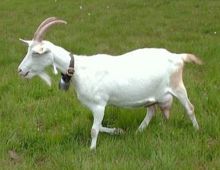These are some types of goat in Malaysia.
1. Jamnapari
Goat
There
is a large variation in color but the typical Jamnapari is white with patches
of tan on the neck and head. Their heads tend to have a highly convex nose,
which gives them a parrot-like appearance. They have long flat drooping ears
which are around 25 cm long. Both sexes have horns. The udder has round, conical teats and is well
developed.They also have unusually long legs.
The
Jamnapari male can weigh up to 120 kg, while females can reach around
90 kg.
The
average lactation yield per day has been found to be slightly less than two
kilograms. Jamnapari meat is said
to be low in cholesterol.
During
the winter they will spend more than 90% of their time grazing, although this
falls to around 55% in the hot Indian summer. The breed browses on bushes, tree
leaves and the top of grasses rather than typical ground grazing. Their mean heart rate
was found to be 127 ± 3.46 in one study.
2.
Boer Goat
Boer goats commonly have white bodies and distinctive brown heads. Some Boer goats can be completely brown or white. Like the Nubian goat, they possess long, pendulous ears. They are noted for being docile, fast-growing, and having high fertility rates. Does are reported to have superior mothering skills as compared to other goats. Mature Boer bucks weigh 110–135 kg, and mature does weigh 90–100 kg.
A high-quality buck can produce high-quality offspring even when mated with an average doe. Boer goats tend to gain weight at about the same rate as their sire, so a buck from a proven fast-growing bloodline will command the highest price, as its offspring will tend to also be fast growers.


3.
Saanen Goat


Saanen
goats are a white or cream-colored breed of goat, named for the
Saanen valley in Switzerland.
They
are among the most popular dairy goat breeds, due to their high productivity
and ease of management.
Saanans
are generally white or cream-colored, although breed associations prefer pure
white. Their coats are usually short and fine, with occasional longer fringes
on the back and hindquarters. Due to their light coloration, they can be
sensitive to harsh sunlight and hot climates. Darker-skinned animals are better
able to handle these conditions. The Sable Saanen is not a crossbreed, but is a recessive expression
of color derived from the white Saanen. Sables can vary in color from beige
through black, with almost any color but pure white (which would be a white
Saanen). Sables are accepted as a breed in their own right in some dairy goat
breed clubs, but not in others.
FAINTING
GOATS
These
is FAINTING GOATS funny
video. A myotonic goat,
otherwise known as the fainting goat, is a domestic goat whose
muscles freeze for roughly 10 seconds when the goat feels panic. This Fainting Goat does
not have in Malaysia.












